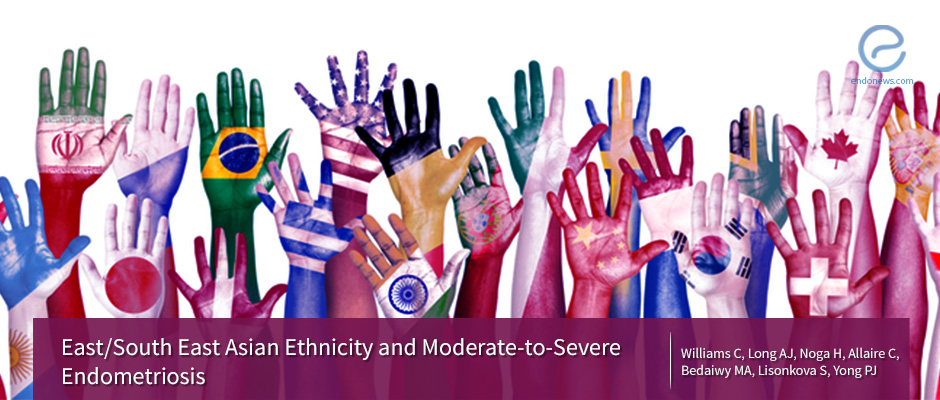East/South East Asian Ethnicity and Moderate-to-Severe Endometriosis
Jun 3, 2020
Differences in the presentation of endometriosis and varying ethnic backgrounds
Key Points
Highlights:
- East/South East Asians may be at higher risk for presenting with advanced endometriosis, than other ethnic groups.
Key Results:
The following were found independent of potential confounders such as age, BMI, past surgical history, and hormone medication use.
- This article observed significantly increased rates of moderate-to-severe endometriosis (stages III-IV) in women of East and South East Asian ethnicity
- The incidence of endometrioma on ultrasound (4.1 times more likely) and incidence of a palpable nodule was also higher (2.7 times more likely) in the East/South East Asian group compared to Caucasian and other ethnicities
- Interestingly, East/South East Asian women reported less pain and better quality-of-life upon questioning.
What’s done here?
- This article aims to address the difference in the incidence of advanced endometriosis between East/South East Asians compared to other ethnic groups.
- In total, 1594 women were included as part of the study’s analysis: Caucasian (1214), East or South East Asian (119) or of other (116) ethnic backgrounds.
Limitations:
- The results of this article are preliminary and need to be addressed in other parts of the world.
Lay Summary
Endometriosis is a chronic inflammatory disease that is defined by the presence of ectopic endometrial tissue outside of the uterus. Understanding how this disease affects diverse groups of people will aid doctors in assessing and diagnosing populations that are high-risk for advanced endometriosis.
This article titled, “East/South East Asian Ethnicity and Moderate-to-Severe endometriosis” published in The Journal of Minimally Invasive Gynecology by Williams et al. from institutions in British Columbia and Alberta, Canada aims to investigate the ethnic differences for moderate-to-severe endometriosis.
This article is a prospective study that investigated data from women presenting with pelvic pain and/or endometriosis who were younger than fifty years of age, not menopausal, and who completed a physical examination and ethnicity questionnaire. Women who self-reported mixed ethnicity were excluded from the study. Patient information was obtained through EPPIC; where information such as clinical history, outcomes, physical examination data, and objective surgical and pathology findings were sorted and analyzed. In total, 1594 women were included as part of the study’s analysis who were of Caucasian (1214), East or South East Asian (119) or of other (116) ethnic backgrounds.
They found that after accounting for age, infertility, BMI, and past surgical and medical history, East South East Asians were 8.3 times more likely than Caucasians to have a previous diagnosis of stage III/IV endometriosis prior to referral. They were also found to be 2.7 times more likely to have a palpable nodule and 4.1 times more likely to have an endometrioma on ultrasound. Interestingly, the study also found that East/South East Asian women reported less pain and better quality-of-life upon questioning.
The etiology of these results is still unknown and needs to be addressed further. Some possible explanations could be that since this population may seem less symptomatic than Caucasian women, their endometriosis could progress further and become more severe before receiving proper treatment. The difference in incidence between East/South East Asians and Caucasians may also be due to genetic polymorphisms that are associated with advanced endometriosis. While preliminary, these results will help doctors and researchers to better understand the complex social, hereditary, and environmental factors that are involved in the pathogenesis of endometriosis in patients of varying ethnic backgrounds.
Research Source: https://www.ncbi.nlm.nih.gov/pubmed/29935381
Asian Ethnicity Severe

